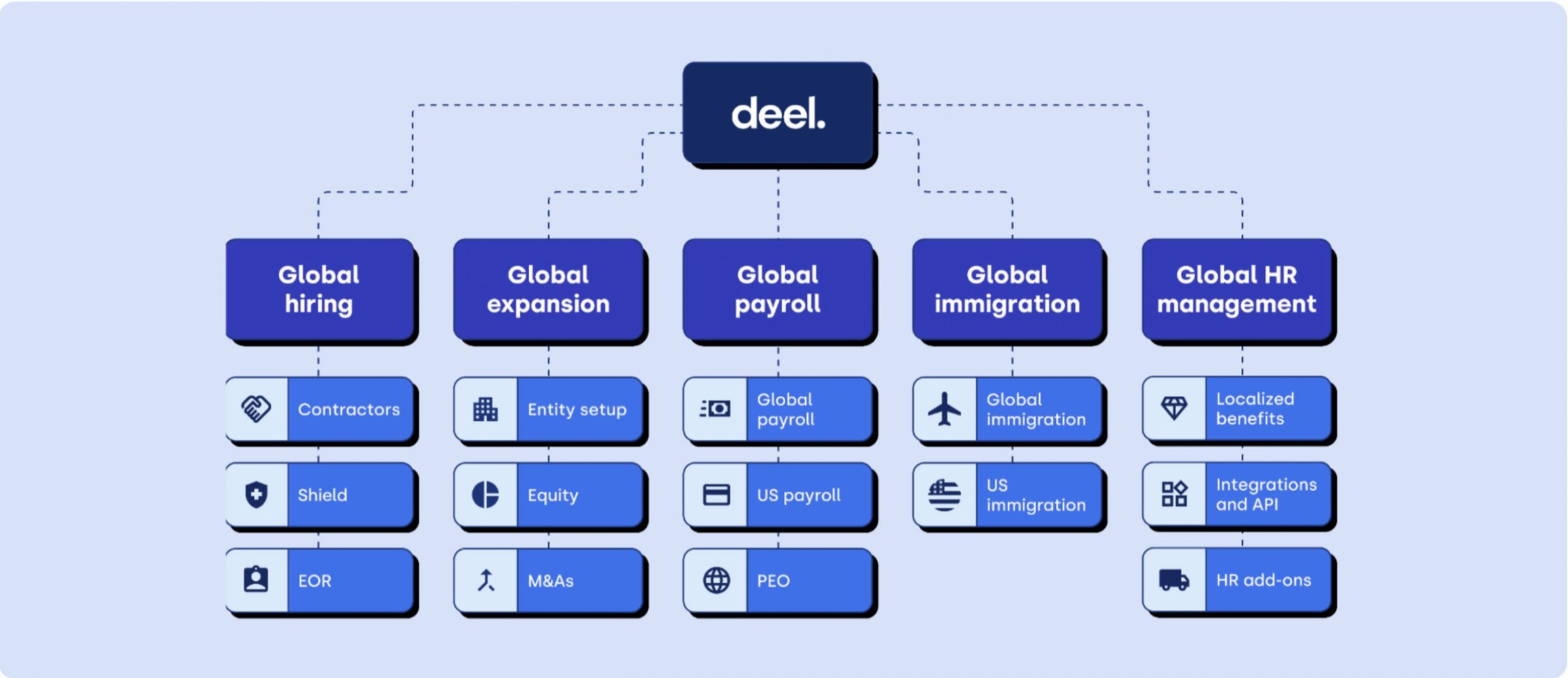In today’s interconnected global economy, regional trade blocs have emerged as economic growth and cooperation powerhouses. Over 300 active trade agreements cover most of the world economy (USD 105 trillion) and its population of 8 billion. Trade blocs facilitate the free movement of goods and services and boost economic activity. They also provide unique labor advantages. However, the inability of businesses of all sizes to optimize workforce strategies within these blocs remains a crucial impediment to gaining a competitive advantage. In recent years, innovative workforce solutions from companies like Deel and others have addressed several pain points for companies seeking to build a multi-regional or global workforce. Given the uncertain geoeconomic environment and rising geopolitical risk, companies are moving toward regional growth models. As such, workforce planning and talent acquisition strategies must keep pace with changing market dynamics. Companies need to prepare.
In this blog post, we explore innovative workforce solutions within the context of the world’s leading trade blocs. We’ll highlight the labor mobility dynamics of the world’s top three trade blocks. We’ll also discuss how small businesses can tap into the labor advantages offered by these economic partnerships. We’ll outline examples of cross-border workforce models and how companies can leverage global hiring and workforce solutions providers like Deel to thrive in the world’s leading trade blocs. Be sure to follow us on LinkedIn. Now, let’s get started.
The Shifting Landscape of Global Labor Mobility
The global labor market, with over 3.6 billion workers, is undergoing rapid transformation, driven by technological advancements, such as AI, and changing work paradigms. These shifts reshape how companies approach workforce planning and talent acquisition, particularly within regional trade blocs. Let’s review some of these trends.
The Rise of Digital Nomadism
The COVID-19 pandemic has accelerated the rise of remote work, untethering many workers from fixed locations. This trend has given birth to a new “digital nomads” class who can work from anywhere with a reliable internet connection. Over 60 countries offer digital nomad or remote work visas. Also, work-from-home trends show no signs of abating. Researchers have determined that the number of remote workers remained stable between 2023 and 2022. This was the first comparison of remote work post-pandemic. With the rapid growth of technology to support remote work and the rise of artificial intelligence, businesses have access to a global talent pool like never before.

Skill-Based Migration and the War for Talent
Countries are increasingly tailoring their immigration policies to attract highly skilled workers in sectors facing shortages. These labor dynamics continue to give rise to the practice of labor hoarding. This trend is particularly evident in the technology, healthcare, and engineering sectors, where labor deficits are significant. As a result, companies must compete not just locally but globally for top talent. For example, Europe faces a labor shortage of over 1 million healthcare workers, forcing countries to tap Asian markets to recruit healthcare talent.

The Expanding Gig Economy
The gig economy continues to grow globally, offering flexible work arrangements that transcend traditional employment models and national boundaries. This shift is creating new opportunities for companies to access specialized skills on demand while also presenting challenges in terms of workforce management and compliance. In the United States, more than 72 million workers are considered independent. This represents more than 45% of the US workforce. In Asia, the growth of platforms such as Grab (Singapore) and GoJek (Indonesia) continues to offer gig workers opportunities for the region’s workforce.
From Brain Drain to Brain Circulation
Instead of a one-way “brain drain,” we’re now seeing more “brain circulation” as skilled professionals move between countries. This movement brings knowledge and expertise across borders, fostering innovation and cross-cultural understanding. These dynamics will evolve as demographics diverge across member states, populations age in some, and incomes rise in others.
The Art of Remote Team Management
As workforces become more distributed, companies continue to develop sophisticated strategies for managing geographically dispersed teams. Technology plays a crucial role in bridging distances and maintaining team cohesion. These trends and opportunities are giving rise to solution providers such as Deel, which offers a range of solutions to fill the gap. However, challenges remain in areas such as global payroll.

Cross-Border Talent Acquisition Strategies
Businesses increasingly look beyond their home countries to find the best talent, regardless of location. This approach requires new strategies for recruitment, onboarding, and retention in a global context.
Understanding Regional Trade Blocs: Gateways to Economic Opportunity
Regional trade blocs are countries that have agreed to reduce or eliminate trade barriers among member states. Blocs have formed across all global regions, providing member states with economic growth opportunities they otherwise would not have had on their own. As of 2020, over 300 active trade agreements were in place, reflecting varying levels of economic integration. These include:

- Preferential Trading Areas: These have low levels of commitment regarding reducing trade barriers. Members agree to reduce or eliminate tariffs on specific goods from other member countries, e.g., (ASEAN – China) or (India – MERCOSUR).
- Free Trade Areas: In free trade areas, most trade barriers (such as tariffs) are removed for goods traded among member countries. However, each member maintains its external trade policies with non-members, e.g., ASEAN Free Trade Areas (AFTA)
- Customs Unions: Customs unions go beyond free trade areas. They eliminate internal tariffs and establish a common external tariff for non-member countries. This means all members apply the same tariffs to imports outside the union, e.g., the Southern African Customer Union or European Customs Union.
- Common Markets: Common markets extend beyond customs unions. In addition to free trade and a common external tariff, they allow for the free movement of factors of production (such as capital and labor) and services, e.g., the European Union or CARICOM.
- Economic and Monetary Unions: These unions involve deeper integration, including a common currency and coordinated monetary policies. Members share a central bank and monetary system, such as the Euro or Eastern Caribbean Dollar.
These economic partnerships offer numerous advantages for businesses operating within their frameworks. Some of these advantages include:
Expanded Markets and Economies of Scale
One of the primary benefits of trade blocs is access to larger consumer markets without facing significant trade barriers. This expanded reach allows companies to achieve economies of scale, potentially leading to cost savings and increased profitability. The population of the member states of the Regional Comprehensive Economic Partnership exceeded 2.3 billion or 30% of the world’s population.
Driving Innovation Through Increased Competition
The larger markets created by trade blocs often lead to increased business competition. While this can be challenging, it drives innovation and efficiency, benefiting companies and consumers. The Intellectual Property protections within the USCMA are the most stringent of any trade bloc. Protections include, among others:
- Safe harbors to combat online piracy
- Enhancements to copyright terms for the life of author (+70) and publication (+75)
- Strong criminal and civil trade secret protections

Attracting Foreign Investment
Trade blocs tend to attract more foreign direct investment due to the potential for accessing multiple markets through a single entry point. This influx of investment can spur economic growth and create new opportunities for businesses of all sizes. Within the USCMA, the United States and Canada accounted for 48% of FDI into Mexico in the first nine months of 2023.
Fostering Political Cooperation
Economic integration often leads to greater political cooperation among member states. This can create a more stable and predictable business environment, reducing risks for companies operating within the bloc. Moreover, political risks diminish as economies become more integrated due to enhanced trade and economic growth.
Creating Integrated Labor Markets
Many trade blocs facilitate easier movement of workers between member countries, creating more dynamic labor markets. This integration can help address skill shortages and create new opportunities for businesses and workers.
Harmonizing Regulations for Smoother Operations
Trade blocs often work towards standardizing regulations across member states. This harmonization can significantly reduce the complexity of operating across borders, making it easier for businesses to expand within the bloc. For example, the movement of persons under the RCEP provides more efficient and transparent permit processing for those involved in trade, goods, services, or investment.
The World’s Three Largest Trade Blocs: Economic Powerhouses
To understand the opportunities trade blocs present, let’s examine the three largest in terms of their share of global GDP, member countries, population, value of trade, and labor advantages.

The European Union: A Model of Economic Integration
The European Union (EU) stands as one of the world’s most integrated trade blocs, comprising 27 member states with a total population of approximately 447 million. In 2021, the EU accounted for about 15% of global GDP and conducted €3.7 trillion in exports and €3.4 trillion in imports.
The EU offers significant labor mobility advantages, including:
- Free movement of workers within the bloc
- Mutual recognition of professional qualifications
- Standardized labor regulations
- A diverse, highly educated workforce
- Strong protections for workers’ rights
Labor mobility across the EU remains robust with over 1.7 million cross-border workers in 2021, a number that was impacted by Covid-19. Many of these workers live in Germany, Italy, and Spain, with origins from Romania, Poland, and Italy. Sectors such as manufacturing and construction account for 45% of the intra-EU workforce. These factors make the EU attractive for companies looking to tap into a skilled and mobile workforce.
USMCA: North American Economic Powerhouse
The United States-Mexico-Canada Agreement (USMCA), which replaced NAFTA, represents a significant economic force. With just three member countries, it encompasses a population of over 510 million. The total GDP within the trade area exceeded 30 trillion, roughly 31% of the global GDP. Additionally, the United States contains nine of the world’s 29 megaregions. It also boasts the world’s leading startup ecosystem. These attributes create substantial interregional and intraregional growth opportunities for SMEs within member states.
The USCMA offers unique labor mobility advantages, including:
- Access to a large, skilled workforce
- Complementary labor markets (e.g., high-tech in the US and Canada, manufacturing in Mexico)
- Provisions for protecting labor rights.
- Facilitated temporary entry for business persons
These features allow companies to leverage the strengths of each member country’s labor market. Over 195 million workers are within the USCMA member states, offering multiple opportunities to optimize and strengthen workforce collaboration and development. Geopolitical uncertainty has given rise to a surge in nearshoring and re-shoring as companies seek to strengthen supply chain resiliency. More importantly, Mexico has now overtaken China as the United States’ largest trading partner.
RCEP: The Rising Giant of Asia-Pacific
The Regional Comprehensive Economic Partnership (RCEP) is the world’s largest trade bloc regarding population and GDP. Comprising 15 Asia-Pacific nations, including China, Japan, South Korea, and Australia, RCEP represents a population of 2.3 billion and about 30% of global GDP.

RCEP’s labor mobility advantages include:
- Access to a vast and diverse labor pool
- A mix of developed and developing economies offering various skill levels
- Potential for knowledge transfer and skill development
- Emerging provisions for easier movement of skilled labor. e.g., Temporary Movement of Natural Persons
The agreement also recognizes the importance of small businesses, which account for 90% of businesses within the member countries. As RCEP continues to develop, it presents significant opportunities for companies looking to tap into the dynamic Asia-Pacific market.
Innovative Workforce Solutions: Maximizing Trade Bloc Advantages
Understanding the unique characteristics of these trade blocs allows companies to implement innovative workforce solutions that leverage their advantages. While the combination of workforce force models is numerous, below are a few ideas and strategies businesses can consider for optimizing human capital within trade blocs.
Cross-Border Talent Pools: Tapping into Diverse Skills
Creating talent pools that span multiple countries within a trade bloc allows companies to access diverse skill sets and cultural perspectives while operating within a relatively harmonized regulatory environment.
Example: A tech company based in Germany could build a team comprising software developers from Poland, UX designers from France, and data scientists from the Netherlands, all operating under EU labor regulations.
Blended Workforce Models: Flexibility Meets Specialization
Developing workforce models that combine full-time employees, contractors, and gig workers across different countries in the trade bloc provides flexibility and access to specialized skills as needed.
Example: A Canadian manufacturing company could maintain a core team of full-time engineers in Toronto while engaging Mexican contractors for specific projects and using U.S.-based gig workers for specialized tasks, all under the USMCA framework.
Skills-Based Immigration Partnerships: Addressing Talent Shortages
Collaborating with governments in trade bloc countries to develop targeted immigration programs can address specific skill shortages in key sectors such as healthcare and education.
Example: An Australian or European healthcare provider could work with other RCEP countries to create a streamlined visa process for nurses and medical technicians. This could address healthcare worker shortages in Australia or New Zealand while providing opportunities for workers from countries like the Philippines or Indonesia. In 2022, New Zealand upgraded nurses to Tier 1 in its Straight to Permanent Residency Program.
Virtual Cross-Border Apprenticeships: Fostering Knowledge Transfer
Establishing virtual apprenticeship programs that pair experienced professionals in one country with emerging talent in another fosters skill development and knowledge transfer across the trade bloc.
Example: A Japanese automotive company could create a virtual apprenticeship program where experienced engineers in Japan mentor early-career engineers in Vietnam or Thailand, all within the RCEP framework.
Rotational Employment Programs: Enhancing Global Competence
Developing programs that allow employees to work for set periods in different countries within the trade bloc enhances their skills and cultural competence.
Example: A French multinational could offer a two-year rotational program where employees spend six months each in France, Spain, Poland, and Sweden, gaining diverse experience while staying within the EU’s free movement framework.
Cross-Border Innovation Hubs: Catalyzing Collaboration
Establishing innovation centers that bring together talent from different countries within the trade bloc fosters collaboration and leverages diverse perspectives.
Example: A U.S.-based technology company could create an innovation hub that brings together AI researchers from Canada, software developers from the U.S., and robotics engineers from Mexico, all collaborating under the USMCA framework.

Leveraging Technology: Deel’s Role in Trade Bloc Workforce Management
As companies seek to implement these innovative workforce solutions, technology plays a crucial role in managing the complexities of cross-border employment. Understanding labor rules, establishing a presence, and hiring and onboarding talent are key challenges for companies seeking to scale regionally or globally. Deel, a Global-first, all-in-one international payroll and HR platform, offers numerous solutions that significantly enhance a company’s ability to leverage the labor advantages offered through regional trade blocs. Some of these advantages include:
Simplifying Global Hiring and Compliance
Deel makes it easy for companies to hire employees or contractors in any country within a trade bloc. The company operates in over 160 countries, providing compliant contracts tailored to local labor laws. Deel local legal partners ensure compliance, reducing the risk of misclassification and future litigation. This capability is crucial for businesses looking to establish teams quickly across multiple countries within a bloc.
The Deel Global Hiring Guide
The Deel Global Hiring Guide helps HR teams understand the breadth and depth of its service offerings worldwide. It’s an essential first stop for planning regional or global workforce strategies.
Streamlining Cross-Border Payroll
With Deel, companies can pay all their workers within a trade bloc through a single platform. The platform handles more than 120 currencies and ensures compliance with local tax regulations. This streamlined approach simplifies financial operations for businesses operating across borders.
Adapting to Changing Regulations
Deel tracks changing labor laws and regulations across trade bloc countries, helping companies stay compliant as they expand their workforce internationally. For countries with higher employment risks, Deel allows businesses to hire employees while reducing the risk of misclassification. This feature is particularly valuable given labor regulations’ complex and evolving nature within trade blocs.
Supporting Flexible Employment Models
The company supports various employment models, including full-time employees, contractors, and other flexible arrangements. This flexibility allows companies to create the blended workforce models that are increasingly common in trade bloc operations.
Facilitating Global Mobility & Scaling
For companies implementing rotational programs or cross-border remote work policies, Deel can help manage the complexities of shifting employee locations within a trade bloc. This support is crucial for maintaining compliance and continuity in cross-border workforce strategies. Deel solutions are designed to support companies in scaling operations. The company offers a free tier for the Deel HR platform for companies under 200 employees.
Embracing the Future of Work in Trade Blocs
The debate of re-globalization/fragmentation continues, accompanied by geopolitical risks and geoeconomic uncertainty. In this environment, regional trade blocs offer significant opportunities for companies to leverage labor advantages and create innovative workforce solutions. They also allow businesses to build regional growth models to weather an uncertain global storm. As such, businesses can build more resilient, diverse, and skilled teams by understanding each bloc’s unique characteristics and implementing strategies that span borders.
The global trends in labor mobility, combined with the economic integration fostered by trade blocs, are creating a new landscape for workforce management. Companies that can navigate this landscape effectively, leveraging tools like Deel and implementing creative cross-border strategies, will be well-positioned to thrive in an increasingly interconnected but rapidly evolving global economy.
As trade blocs evolve and potentially expand, the opportunities for innovative workforce solutions will only grow. Forward-thinking companies that embrace these opportunities and build flexible, bloc-spanning workforce strategies will gain a significant competitive advantage in the global marketplace.
In this new era of work, the most successful companies will be those that can think beyond traditional boundaries, leveraging the unique advantages trade blocs offer to create truly global, diverse, and dynamic workforces. By doing so, they’ll drive their success and contribute to the broader economic integration and prosperity that trade blocs aim to achieve.
Disclosure: At ClearSky 2100, our portfolio partly consists of affiliate partnerships. We may earn a small commission from buying links on our site at no cost to you.








